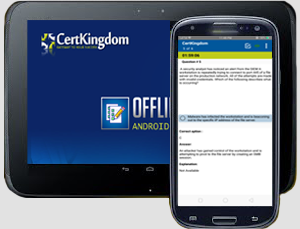Exam: 70-446

|
|||||||||||||||||||||||||||
Certkingdom's preparation material includes the most excellent features, prepared by the same dedicated experts who have come together to offer an integrated solution. We provide the most excellent and simple method to pass your certification exams on the first attempt "GUARANTEED"
Whether you want to improve your skills, expertise or career growth, with Certkingdom's training and certification resources help you achieve your goals. Our exams files feature hands-on tasks and real-world scenarios; in just a matter of days, you'll be more productive and embracing new technology standards. Our online resources and events enable you to focus on learning just what you want on your timeframe. You get access to every exams files and there continuously update our study materials; these exam updates are supplied free of charge to our valued customers. Get the best 70-446 exam Training; as you study from our exam-files "Best Materials Great Results"
70-446 Exam + Online / Offline and Android Testing Engine & 4500+ other exams included
$50 - $25 (you save $25)
Buy Now
70-446
PRO: Designing a Business Intelligence Infrastructure by Using Microsoft SQL Server 2005
Credit toward certification
When you pass this exam, you earn credit toward the following certification:
MCITP: Business Intelligence Developer
This Training will Cover
Planning BI Solutions
Select appropriate BI technologies.
Specify the appropriate SQL Server edition.
Design dimensional models.
Design dimensions for each subject area.
Design fact tables for each subject area.
Design a physical schema based on a logical design.
Identify current dimensions that can be reused.
Identify elements that must be added to existing dimensions or fact tables.
Design new physical objects based on a logical model.
Design indexing, partitioning, and key structures for the relational database.
Design an indexing strategy.
Design a surrogate key strategy.
Identify appropriate business keys.
Design a partitioning strategy.
Designing SSIS Solutions
Design the extract process.
Identify design constraints.
Identify changed data in the source system.
Decide the strategy for decoding textual values.
Design the load process.
Decide whether to implement fast load.
Design appropriate destination components to handle new and updated records during incremental loads.
Design the transformation process.
Identify appropriate transformations and transformation options.
Design data flow.
Design the control flow process.
Identify appropriate control flow items.
Design the control flow sequence.
Design logging and event handling.
Identify appropriate uses and placement of event handlers.
Identify appropriate uses and placement of checkpoints.
Identify appropriate uses of logging.
Identify appropriate uses of data flow error handling.
Designing SSRS Solutions
Acquire report data.
Select appropriate uses of shared data sources.
Select appropriate uses of stored procedures or user-defined functions.
Design security for SSRS.
Define appropriate security roles.
Specify folder security.
Specify field-level security.
Choose an SSRS report creation strategy.
Select appropriate uses of Report Designer.
Select appropriate uses of Report Definition Language (RDL).
Select appropriate uses of Report Builder.
Select appropriate report components.
Decide appropriate uses of datasets.
Decide appropriate uses of subreports.
Decide the appropriate placement of extensive business logic.
Design report execution modes to support business requirements.
Identify appropriate uses of report snapshots.
Identify appropriate uses of on-demand reports.
Identify appropriate uses of on-demand-from-cache reports.
Design a report subscription strategy.
Identify appropriate uses of standard subscriptions.
Identify appropriate uses of data-driven subscriptions.
Identify appropriate report-delivery methods for subscriptions.
Design a strategy to maintain SSRS objects on the report server.
Identify appropriate uses of the Reporting Services Web Service library.
Identify appropriate uses of the Reporting Services Configuration tool.
Designing SSAS Solutions
Design the data source view (DSV).
Select appropriate uses of named queries.
Select appropriate uses of named calculations.
Select appropriate uses of denormalization strategies.
Modify the SSAS dimensions.
Identify appropriate uses of attribute relationships.
Identify appropriate uses of column binding to support a user-defined reporting hierarchy.
Select a design for implementing a ragged hierarchy.
Select an appropriate strategy to implement member properties.
Modify the SSAS cube.
Identify appropriate uses of calculated members.
Identify appropriate uses of actions.
Identify appropriate uses of key performance indicators (KPIs).
Identify appropriate uses of perspectives.
Identify appropriate uses of translations.
Identify appropriate uses of drillthrough.
Design relationships between dimensions and measure groups.
Identify a relationship type.
Identify appropriate uses of role-playing dimensions.
Choose an appropriate strategy to handle unknown dimension members.
Design security for SSAS.
Define appropriate security roles.
Design dimension security.
Design cell security by using Multidimensional Expressions (MDX).
Maintaining and Optimizing SSAS Solutions
Select an appropriate aggregation strategy.
Maintain SSAS solutions by using either online or offline methods.
Ensure that the SSAS solutions are refreshed with the most recent data.
Design a partitioning strategy for optimal data availability.
Decide whether proactive caching is an appropriate solution.
Select appropriate processing methods for SSAS objects.
Select appropriate storage settings.
Design partition storage settings.
Select a dimension storage mode.
Designing Data Mining Solutions
Identify applicability of data mining to a business need.
Design the data structure to support mining.
Design a data mining model.
Identify appropriate algorithms to meet requirements.
Classify data as input, key, predict, and ignore.
Select data mining delivery methods.
Select appropriate uses of SSRS Data Mining Extensions (DMX) queries.
Select appropriate uses of ActiveX Data Objects (Multidimensional) (ADOMD).
Select appropriate uses of SSIS Data Mining Query tasks.
Select appropriate uses of data mining viewer controls for Microsoft .NET Framework-based applications.
Select a processing method for data mining objects.
Select appropriate uses of processing.
Select appropriate uses of structure processing.
Select appropriate uses of default processing.
Make yourself more valuable in today's competitive computer industry Certkingdom's preparation material includes the most excellent features, prepared by the same dedicated experts who have come together to offer an integrated solution. We provide the most excellent and simple method to pass your Microsoft MCITP 70-446 exam on the first attempt "GUARANTEED".
Unlimited Access Package
will prepare you for your exam with guaranteed results, 70-446 Study Guide. Your exam will download as a single 70-446 PDF or complete 70-446 testing engine as well as over +4000 other technical exam PDF and exam engine downloads. Forget buying your prep materials separately at three time the price of our unlimited access plan - skip the 70-446 audio exams and select the one package that gives it all to you at your discretion: 70-446 Study Materials featuring the exam engine.
Certkingdom 70-446 Exam Prepration Tools
Certkingdom Microsoft MCITP preparation begins and ends with your accomplishing this credential goal. Although you will take each Microsoft MCITP online test one at a time - each one builds upon the previous. Remember that each Microsoft MCITP exam paper is built from a common certification foundation.
70-446 Exam Testing Engines
Beyond knowing the answer, and actually understanding the 70-446 test questions puts you one step ahead of the test. Completely understanding a concept and reasoning behind how something works, makes your task second nature. Your 70-446 quiz will melt in your hands if you know the logic behind the concepts. Any legitimate Microsoft MCITP prep materials should enforce this style of learning - but you will be hard pressed to find more than a Microsoft MCITP practice test anywhere other than Certkingdom.
70-446 Exam Questions and Answers with Explanation
This is where your Microsoft MCITP 70-446 exam prep really takes off, in the testing your knowledge and ability to quickly come up with answers in the 70-446 online tests. Using MCITP 70-446 practice exams is an excellent way to increase response time and queue certain answers to common issues.
70-446 Exam Study Guides
All Microsoft MCITP online tests begin somewhere, and that is what the Microsoft MCITP training course will do for you: create a foundation to build on. Study guides are essentially a detailed Microsoft MCITP 70-446 tutorial and are great introductions to new Microsoft MCITP training courses as you advance. The content is always relevant, and compound again to make you pass your 70-446 exams on the first attempt. You will frequently find these 70-446 PDF files downloadable and can then archive or print them for extra reading or studying on-the-go.
70-446 Exam Video Training
For some, this is the best way to get the latest Microsoft MCITP 70-446 training. However you decide to learn 70-446 exam topics is up to you and your learning style. The Certkingdom Microsoft MCITP products and tools are designed to work well with every learning style. Give us a try and sample our work. You'll be glad you did.
70-446 Other Features
* Realistic practice questions just like the ones found on certification exams.
* Each guide is composed from industry leading professionals real Microsoft MCITPnotes, certifying 100% brain dump free.
* Study guides and exam papers are guaranteed to help you pass on your first attempt or your money back.
* Designed to help you complete your certificate using only
* Delivered in PDF format for easy reading and printing Certkingdom unique CBT 70-446 will have you dancing the Microsoft MCITP jig before you know it
* MCITP 70-446 prep files are frequently updated to maintain accuracy. Your courses will always be up to date.
Get MCITP ebooks from Certkingdom which contain real 70-446 exam questions and answers. You WILL pass your MCITP exam on the first attempt using only Certkingdom's MCITP excellent preparation tools and tutorials.
These are real testimonials. Hi friends! CertKingdom.com is No1 in sites coz in $50 I cant believe this but when I purchased the $50 package it was amazing I Microsoft passed 10 Exams using CertKingdom guides in one Month So many thanks to CertKingdom Team , Please continue this offer for next year also. So many Thanks
Mike CA
Thank You! I would just like to thank CertKingdom.com for the Microsoft MCITP 70-446 test guide that I bought a couple months ago and I took my test and pass overwhelmingly. I completed the test of 86 Questions questions in about 90 minutes I must say that their Q & A with Explanation are very amazing and easy to learn.
Jay Brunets
After my co-workers found out what I used to pass Microsoft MCITP 70-446 the test, that many are thinking about purchasing CertKingdom.com for their MCITP exams, I know I will again
John NA
I passed the Microsoft MCITP 70-446 exam yesterday, and now it's on to security exam. Couldn't have done it with out you. Thanks very much.
Oley R.
Hello Everyone
I Just Passed The Microsoft MCITP 70-446 Took 80 to 90 Minutes max to understand and easy to learn. Thanks For Everything Now On To 70-446
Robert R.
Hi CertKingdom.com thanks so much for your assistance in Microsoft MCITP i passed today it was a breeze and i couldn't have done it without you. Thanks again
Seymour G.
I have used your Exam Study Guides for preparation for Microsoft MCITP 70-446. I also passed all those on the first round. I'm currently preparing for the Microsoft and theMCITP. exams
Ken T.
I just wanted to thank you for helping me get myMCITP $50 package for all guides is awesome you made the journey a lot easier. I passed every test the first time using your Guide
Mario B.
I take this opportunity to express my appreciation to the authors of CertKingdom.com Microsoft MCITP test guide. I purchased the 70-446 soon after my formal hands on training and honestly, my success in the test came out of nowhere but CertKingdom.com. Once again I say thanks
Kris H.
Dear CertKingdom.com team the test no. 70-446 that i took was very good, I received 880 and could have gain more just by learning your exams
Gil L.
Hi and Thanks I have just passed the MCITP Directory Services Design exam with a score of 928 thanks to you! The guide was excellent
Edward T.
Great stuff so far....I love this site....!! I am also on the Microsoft MCITP I decided to start from certkingdom and start learning study MCITP from home... It has been really difficult but so far I have managed to get through 4 exams....., now currently studying for the more exams.... Have a good day.................................................. Cheers
Ted Hannam
Thanks for your Help, But I have finally downloaded Microsoft MCITP 70-446 exam preparation from certkingdom.com they are provided me complete information about the exam, lets hope I get success for the 70-446 exam, I found there exams very very realistic and useful. thanks again
lindsay Paul
Certkingdom Offline Testing Engine Simulator Download
Prepare with yourself how CertKingdom Offline Exam Simulator it is designed specifically for any exam preparation. It allows you to create, edit, and take practice tests in an environment very similar to an actual exam.
Supported Platforms: Windows-7 64bit or later - EULA | How to Install?
FAQ's: Windows-8 / Windows 10 if you face any issue kinldy uninstall and reinstall the Simulator again.
Download Offline Simulator-Beta
Certkingdom Testing Engine Features
- Certkingdom Testing Engine simulates the real exam environment.
- Interactive Testing Engine Included
- Live Web App Testing Engine
- Offline Downloadable Desktop App Testing Engine
- Testing Engine App for Android
- Testing Engine App for iPhone
- Testing Engine App for iPad
- Working with the Certkingdom Testing Engine is just like taking the real tests, except we also give you the correct answers.
- More importantly, we also give you detailed explanations to ensure you fully understand how and why the answers are correct.
Certkingdom Android Testing Engine Simulator Download
Take your learning mobile android device with all the features as desktop offline testing engine. All android devices are supported.
Supported Platforms: All Android OS EULA
Install the Android Testing Engine from google play store and download the app.ck from certkingdom website android testing engine download

Certkingdom Android Testing Engine Features
- CertKingdom Offline Android Testing Engine
- Make sure to enable Root check in Playstore
- Live Realistic practice tests
- Live Virtual test environment
- Live Practice test environment
- Mark unanswered Q&A
- Free Updates
- Save your tests results
- Re-examine the unanswered Q & A
- Make your own test scenario (settings)
- Just like the real tests: multiple choice questions
- Updated regularly, always current




